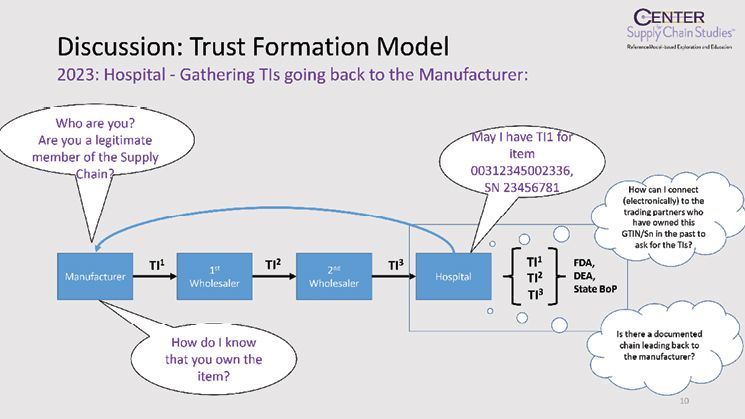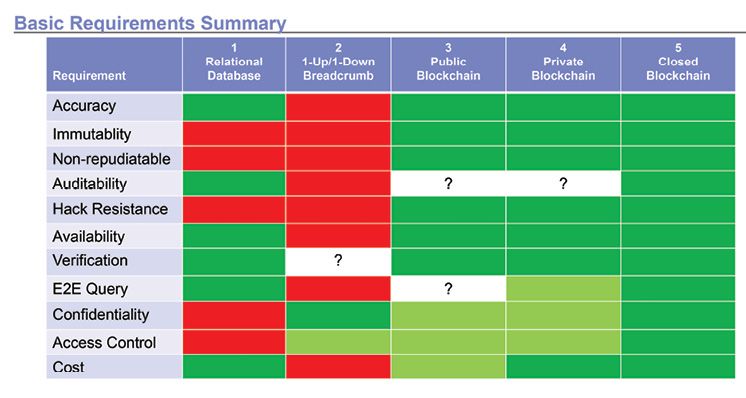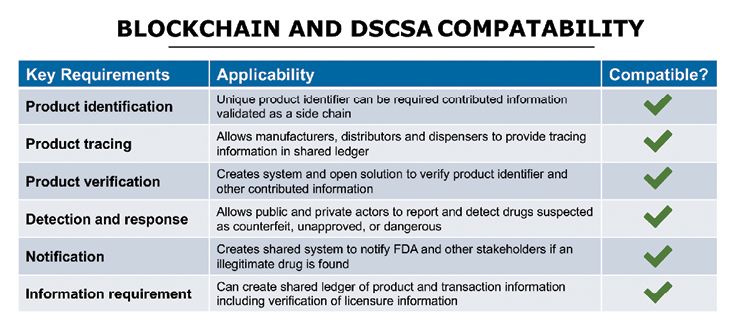Blockchain: the technology to make DSCSA work after 2023?
Industry experts are grappling with the eventual requirement to provide accurate supply-chain traceability

Fig. 1. A part of the traceability problem under current DSCSA guidance: how does a hospital pharmacy (at the far right) know to connect with the manufacturer at the far left to verify a pharma package’s serial number? Credit: C4SCS[/caption]
Not withstanding FDA’s June 30 announcement
that it was delaying enforcement of the Drug Supply Chain Security Act’s next phase by one year (November 2017 to November 2018), the global pharma industry will have invested several billion dollars in hardware and software to comply with that law and related efforts to secure the pharma supply chain around the world. And while other countries have their own pathway toward providing traceability of pharma shipments, the US’ effort has a small problem: as written, no one knows how the law will work effectively by 2023 when all of its components are to be in place. Oops!
To be sure, there are many, many details keeping IT managers, packaging engineers and logistics specialists up at night, brainstorming ways to address knotty issues like aggregation (the need to identify what serialized numbers are within a carton of many packages of serialized product), product returns (which need to be re-verified before being re-entered into trade) and the millisecond-level response time a traceability system will call for. Smart, collaborative efforts going on now will address many of these details. But the bigger problem (see box) is: how to determine the chain of custody of a pharma package that might show up on a pharmacy shelf, when no one authority or source has all the information about the product transfers that brought the package to the shelf? (Fig. 1) In other words, how to verify the integrity and authenticity of an individual pharma package—which is the original goal of the entire DSCSA framework?
Enter the blockchain topic. By essentially making the storage of transaction data (such as the sale of a pharmaceutical product from a manufacturer to a wholesaler) a secure, unalterable yet sharable message, blockchain has the potential to streamline the data-storage and -access problem. It also has the potential to make this data process relatively inexpensive to set up (cloud-based data storage being one of the main operating expenses). But the technology is relatively unproven in commercial transactions, and executives involved with current DSCSA implementation difficulties will be loath to take on yet more burdens. However, blockchain is advancing fairly rapidly; developers are attracting venture capital, and it’s conceivable that the technology could be ready to use by the time the 2023 DSCSA deadline arrives.
Blockchain has major developmental commitments at IT systems houses such as IBM, Unisys, Deloitte, Accenture and others. In March, two San Francisco, CA companies—a blockchain startup called Chronicled, and a pharma supply-chain consultancy, the LinkLab, announced a DSCSA-oriented pilot program (they say they have the support of a major pharma company). iSolve, an East Norriton, PA consultancy, is exploring blockchain applications in various life sciences tasks, including supply chain traceability. Rubix, a Toronto, Canada blockchain development company supported by Deloitte, is exploring a variety of supply-chain-related applications.
A number of these efforts come together at the Center for Supply Chain Studies (C4SCS), a nonprofit group set up by Robert Celeste, a former executive with the GS1 organization (GS1 has a number of standards specific to healthcare data tracking, notably the EPCIS standard, which is fundamental to DSCSA compliance.) C4SCS is currently running a workgroup that meets monthly to explore blockchain applications to DSCSA compliance.
The vendors of DSCSA-enabling software currently being installed at pharma companies and their trading partners appear to be keeping a wait-and-see attitude toward blockchain. One exception is TraceLink, the industry leader in DSCSA compliance implementations, which is a member of C4SCS, and recently announced a service to help its customers transfer compliance data among themselves (the catch here is that at least one of the parties needs to be a TraceLink client, so non-TraceLink transactions will remain outside its system).
Blockchain basics
The comparison has been frequently made that blockchain technology today is very much like the internet was
circa
1990: Something important was going on, led by a disorganized mass of self-proclaimed experts; substantially different methods to effect communication were competing for attention and market share; and there was enormous potential but no clear way of achieving it.
Most people associate blockchain with what they’ve heard about bitcoin—a nongovernmental currency that somehow retains value simply because the people using it (or having it) agree on that value. Bitcoin’s driving force as external to government also gives blockchain an outlaw air, which doesn’t help matters. But the reality is that there is much more to blockchain than bitcoin and that problems of verifying transactions of many types besides bitcoin “cryptocurrency” are attracting intense interest from IT developers. In this broader context, the “blockchain” concept itself is losing out to “distributed ledger” technology (iSolve, for one, prefers to speak about “advanced digital ledger technology,” or ADLT, rather than blockchain.)
A distributed ledger is simply a list of records (such as transactions) that is stored on multiple, separate IT systems in a network. Each new record—and each query or interaction with a record—becomes a recordable event itself in the ledger. When this is combined with powerful identity management tools (which can either be a distributed-ledger process itself, or some variation of identity-security methods) a “non-repudiatable” record is created, and thus, trust between two parties to
a transaction.
Another cross-cutting concept in distributed ledgers is the “smart contract”—a set of code that automatically takes an action (such as authorizing a payment) when preprogrammed steps have been followed. In theory, a smart contract could become the equivalent of the Transaction History (TH) document specified by DSCSA—the set of records that establishes that Party A sold Product X to Party B, with the identity of the two parties and the product verified (i.e., is non-repudiatable).
An example of how far blockchain or distributed-ledger technology has to go is that the concept of a smart contract, as opposed to a piece of paper with two signatures on it, is yet to be accepted in courts of law or international trade agreements.
Like the early days of the internet, when IT developers were grappling with Ethernet, the TCP/IP protocol, the World Wide Web and other concepts, today’s blockchain developers have created a growing list of data-exchange platforms or protocols (or protocols that are platforms). Ethereum, a relatively new cryptocurrency platform, is being promoted by, among others, IBM and Microsoft. Others include such systems as Blockstream, Everledger, Bloq, Fabric, Lightning Network—the list is long and growing. A parallel effort has been going on to establish a reliable identity-management protocol; in this context, the efforts of the SAFE-Biopharma organization is notable, since its processes are tailored to the needs of the life sciences industries.
Another foundational component of blockchain networks is how they are administered—who makes and enforces rules about members and permissible actions within the network? Some platforms are designed intentionally so that no one is the administrator—the system itself ensures that all parties are legitimate and carrying out legitimate activities. Others call for a centralized administrative function. These concepts, in turn, define a “public” blockchain network—where anyone can participate—from a private network, where only trusted parties can engage.
The DSCSA compliance endpoint, for all this technology, is a system where each sale of a specific package of pharmaceuticals can be traced back to the point of origin, and each party involved in the chain of custody is verified. It is possible to limit how much data is exposed during a track-and-trace process by limits imposed either by the network itself or by specific trading partners (for example, no one is interested in sharing the price information of a transaction)—but the details of this remain to be worked out.
Bob Celeste at C4SCS has identified five obstacles to implementing blockchain for DSCSA today:
- Establishing an electronic connection between non-adjacent trading partners, i.e., a connection between, say, a wholesaler who bought product from a manufacturer directly, then sold it to a second wholesaler. The second wholesaler is “non-adjacent” to the manufacturer.
- Establishing trust between these trading partners, that is, to verify the identity of the parties.
- Sharing required data without inadvertently exposing proprietary information.
- Reduce the potential activity required of trading partners—for example, attempting to manually account for the transaction records of a returned product.
- Funding the architecture.
C4SCS has created a simulator to run analyses of blockchain-based supply-chain activities, such as handling a product return, or matching a product’s transaction with discounts such as copay cards. There can be various ways to record and share the information, with pluses and minuses for each setup.

Fig. 2. Various data-communication methods have limitations to meet expected DSCSA requirements. Key: Dark green—sufficient; light green—some limitations; red—fails. Credit: J. Stollman[/caption]
At a June meeting organized by the IEEE Society (which could have a hand in creating an industry standard for blockchain, as it has for a wide variety of electronic or digital technologies), Jeff Stollman, an industry consultant, assessed the potential advantages and disadvantages of current concepts for DSCSA traceability. (Fig. 2) The simplest, a conventional relational database managed by each manufacturer for its products, falls down because each database owner is responsible for the accuracy, reliability and security of its own database.
The “breadcrumb” approach—where transaction records are shared between each pair of trading partners (“one up and one down”) but no one else—is appealing for its practicality, but falls down on many aspects of data security, and is probably more costly if implemented, since each trading partner must maintain its own database and data-access system. A public blockchain has problems with access security. A private blockchain, which Stollman specifies as having decentralized administration, has questionable access and confidentiality issues, while only a closed blockchain, distinguished by having centralized control, meets all the potential criteria he has called out.
There is both a potential downside to current plans for DSCSA compliance (which are basically to have individual databases and let FDA, or other regulator, figure out how to access information when an investigation needs to occur), and a potential upside to use of blockchain technology, says Stollman. “The discovery of ‘suspect’ product will occur only when there is a public health crisis. The likelihood that the thousands of repositories holding each firm’s data in its own silo will all be available and operationally compatible when a crisis does arise is statistically unlikely.” On the other hand, “The potential offered by blockchain is to proactively discover suspect product in the supply chain before a bad drug gets into the hands of the public and creates a public health crisis. The technology is available to do this.” However, there are “significant” governance issues to be resolved over how the blockchain would be managed.

Fig. 3. As blockchain technology is generally understood, it is well suited to meeting
operational requirements of DSCSA compliance. Credit: Prof. Tim Mackey, UC San Diego[/caption]
Getting a handle on those governance issues is a large part of what Celeste’s Center for Supply Chain Studies is focused on, at least when it comes to blockchain. Celeste says that the simulation software the group uses has been set up with the typical parameters of various trading partners in the supply chain—manufacturer, wholesaler, retailer and the like—and then scenarios can be played out based on various criteria, such as the appearance of an unaccounted-for serial number in the supply chain, or a product recall with expired product.
“The concept of ‘smart contracts,’ which is built into the Ethereum platform, looks promising,” he says, based on the fact that the code could be set up to answer a product-authentication question (does this serial number exist?) without necessarily revealing every piece of information about the serial number. And it can be done very quickly—valuable in a scenario, for example, where a wholesaler is trying to verify returned product that is still saleable.
Celeste’s work group has attracted a cross-section of industry players—and that has value all by itself since each player has a different perspective on needs and capabilities. Participants include Pfizer and Merck, Cardinal Health and AmerisourceBergen, the Geisinger health system, the Healthcare Distribution Alliance, Rx-360 (an industry consortium), and industry software developers iSolve, TraceLink, Unisys and Verify Brand. Mention of longtime traceability vendors like TraceLink and Verify Brand brings up the interesting question whether blockchain will replace part of what these vendors have been doing—creating the mechanism by which stored data can be made available to trading partners. (Fig. 3) The consensus, at the moment, is that blockchain technology is complementary and not competitive to the software that collects serial numbers from packaging lines and stores them.
Initial ‘coin’ offering
At iSolve, CEO Gordon Tampol emphasizes that his company provides blockchain consulting services and code that “sits on top of” a blockchain platform (such as Ethereum or HyperLedger), and is therefore platform-agnostic. The company is working on multiple blockchain applications besides DSCSA compliance, but for that application in particular, it is preparing to launch a pilot, using its distributed-ledger software (which has been branded as Advanced Digital Ledger Technology, or ADLT) and—hold your breath—a cryptocurrency it is branding as PharmaCoin. (Side note: it has become common, among blockchain startups, to hold an “initial coin offering,” or ICO, rather than the conventional IPO of startups. Investors pay dollars for coin, and then the coin becomes the medium of transactions within the network, with participants earning coins by virtue of hosting data or providing network support. If the network proves useful, the coin will rise in value, benefitting the initial investors and creating a way for new participants to join in.)
“Given that we did not see the industry coming together around a single solution, we implemented a revenue model using the ADLT PharmaCoin as a way to offset the implementation cost and to incentivize trade partners for data acquisition or providing consensus,” says Tampol. “To ensure a more predictable cost to the life sciences and healthcare industries, we will alter the transaction cost to place/retrieve information from the Blockchain to account for external market forces.”
Efforts like C4SCS, iSolve and the other developers in this field have a ways to go before there will be an industry consensus around addressing DSCSA compliance; most industry observers feel that it’s still early days for commercial application. On the other hand, the energy around blockchain in other industries, such as financial services and banking, is truly intense. It could be that, by 2023, enough commercial activity will have occurred that a transition to a blockchain-enabled traceability network will become a matter of course.
The DSCSA traceability mandate
The 2023 DSCSA all-digital transaction statement mandates the following of manufacturers and their trading partners, who shall have:
The systems and processes necessary to promptly facilitate gathering the information necessary to produce the transaction information for each transaction going back to the manufacturer, as applicable, shall be required—
(i) in the event of a request by the Secretary (or other appropriate Federal or State official), on account of a recall or for the purposes of investigating a suspect product or an illegitimate product; or
(ii) in the event of a request by an authorized trading partner, in a secure manner that ensures the protection of confidential commercial information and trade secrets, for purposes of investigating a suspect product or assisting the Secretary (or other appropriate Federal or State official) with a request described in clause (i)
Save
Save
